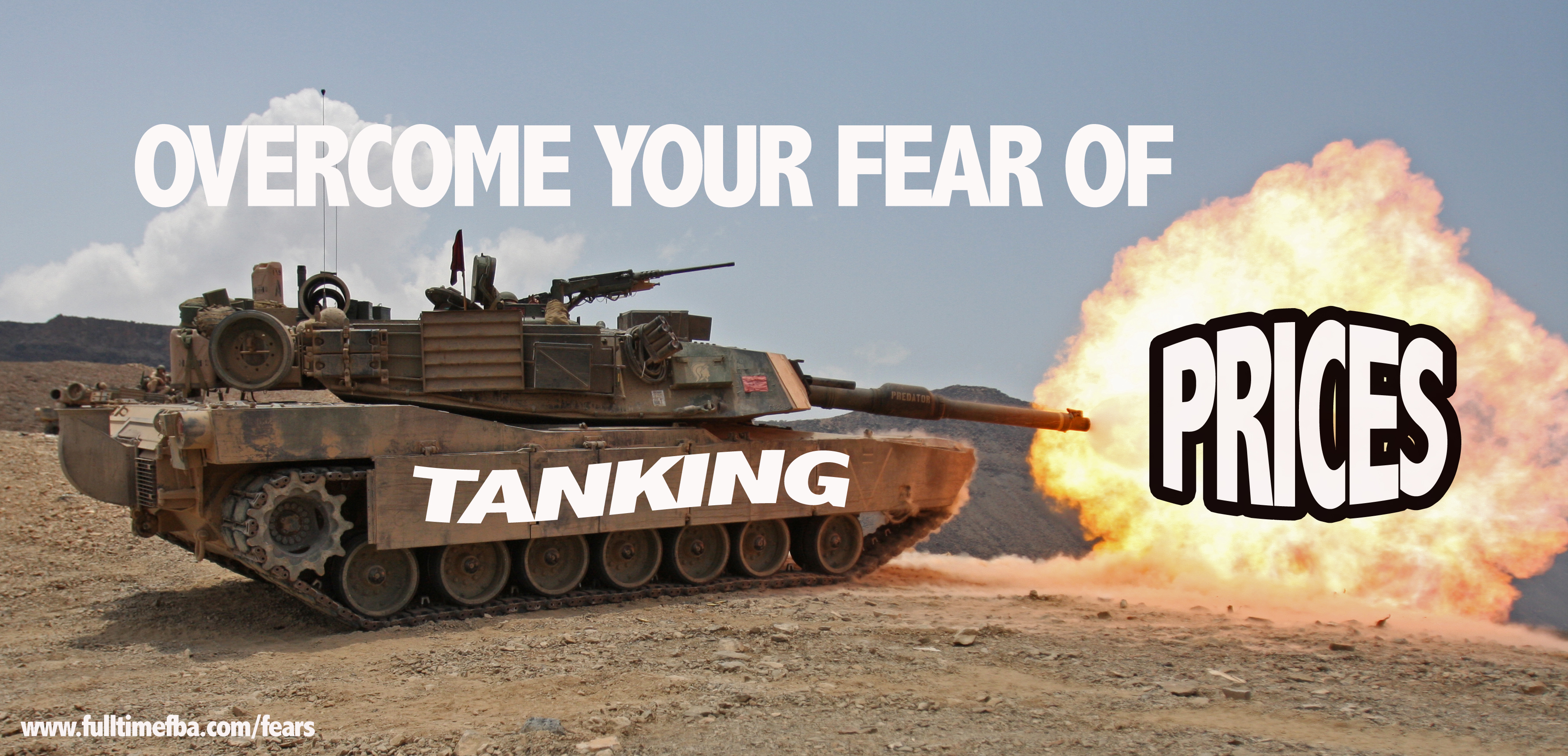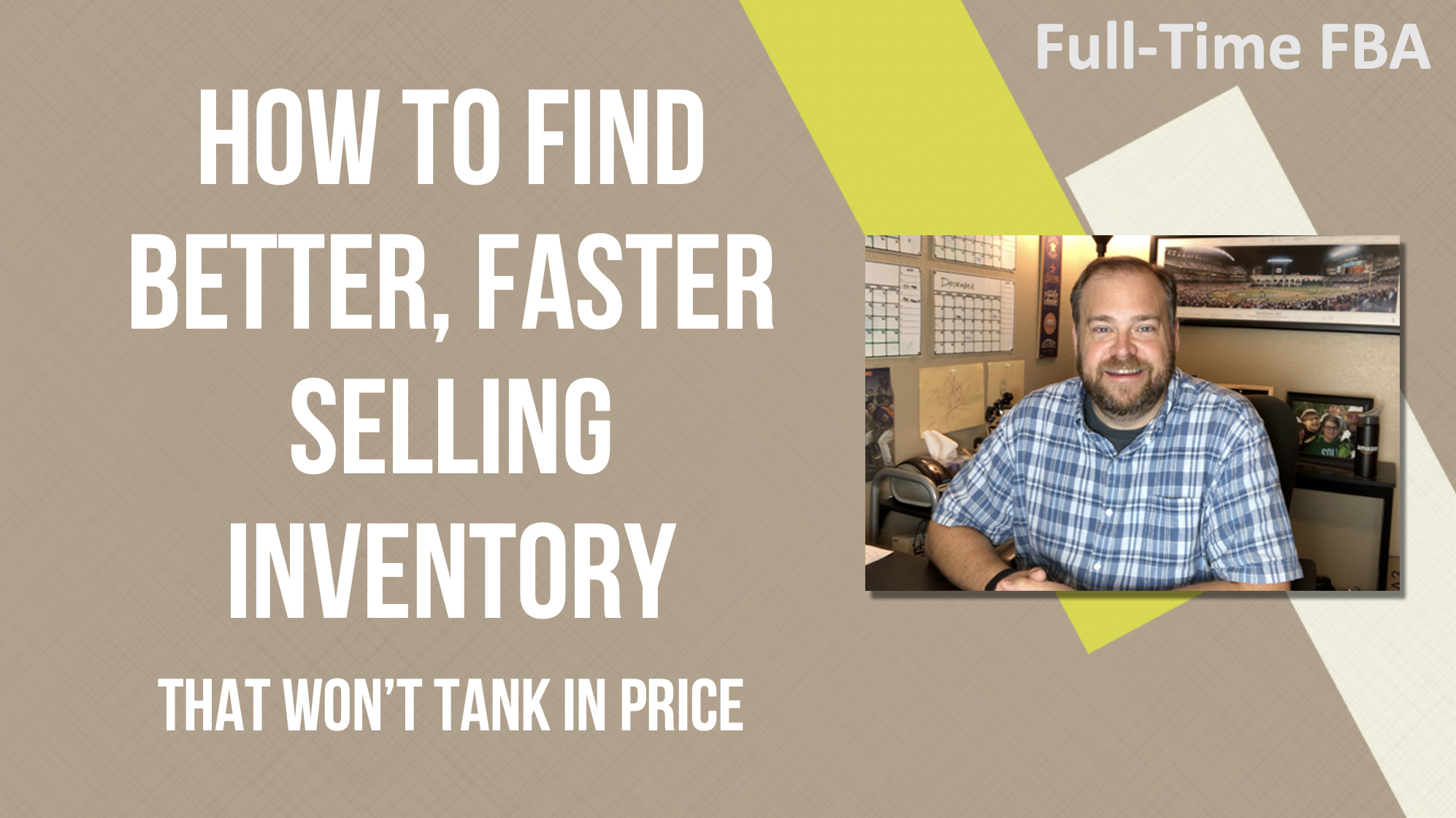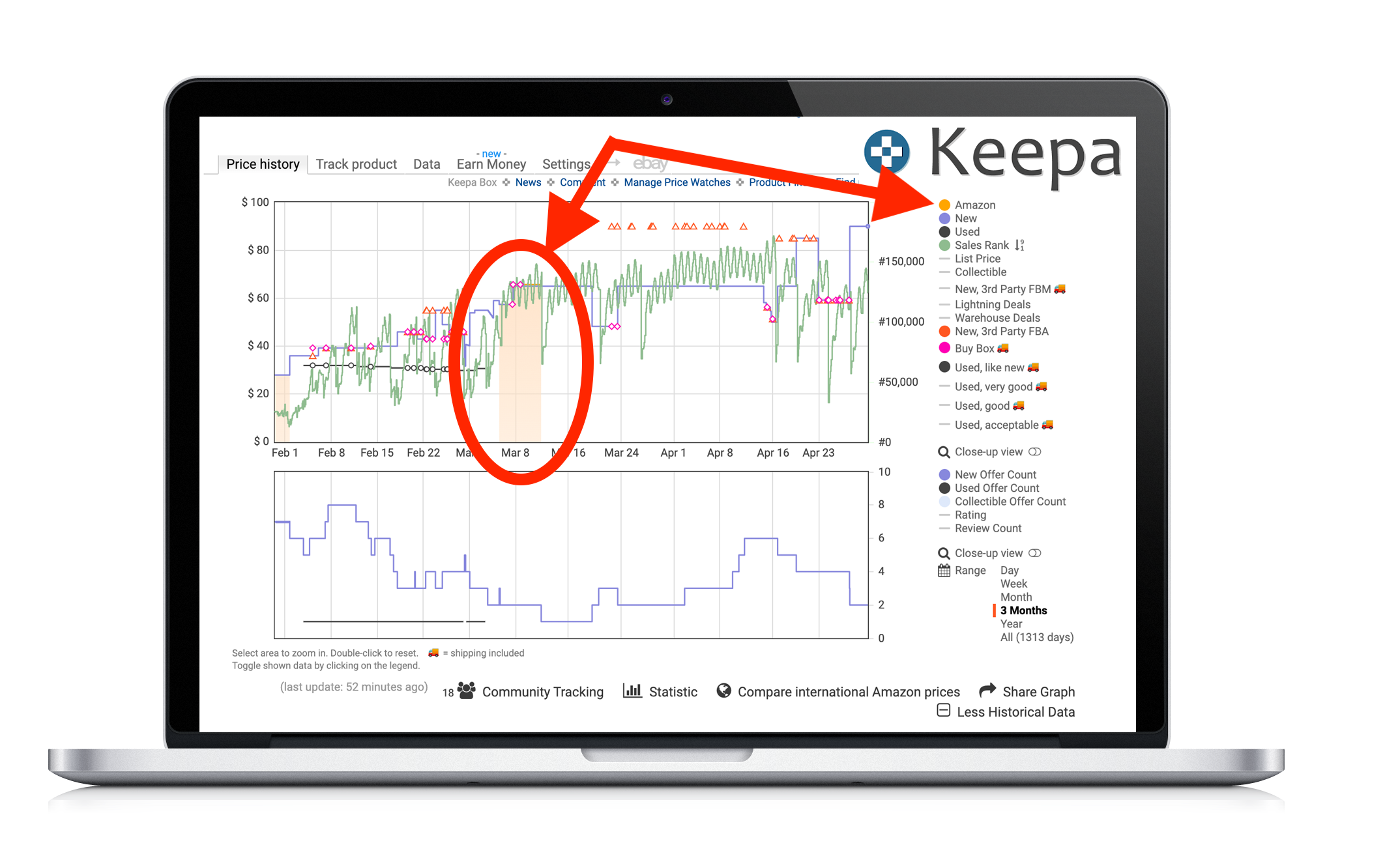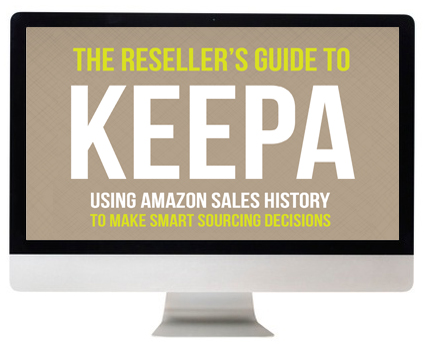No Amazon seller likes it when their items start tanking in price. When prices go down, so do potential profits. On today’s episode of Full-Time FBA we dive into a 4-week Fear Series with the topic of how to tackle overcoming your fear of tanking prices. We go into how to avoid tanking prices and how to deal with situations when prices do in fact tank.
When you’re out sourcing for inventory you might worry about going “too deep” on an inventory buy because you fear that the price might tank, leaving you with excess inventory that’s not going to sell unless you lower your price too. Is the solution always to lower your price? Not at all. In this episode we’ll show you how to make better sourcing decisions to help you find inventory that will hold its higher price. We’ll also chat through some ways to respond if you see the price is starting to tank on your items and strategies to sell your item fast before the price tanks too low.
Listen on the podcast player below.
Like what you hear? Tell a friend… and be sure to leave us a rating and a review. Here’s how.
Key points from Episode 52:

- The top reasons prices tank on Amazon
- Situations where Amazon sellers most fear the possibility of prices tanking.
- What “going deep on an item” means
- An example of a way that Amazon sellers can lower their risk of buying items that tank in price
- The importance of understanding what it means when “prices are fluid”
- The best way to respond when you see the price is tanking on an item that you have
- And more!
Links and resources mentioned in this episode:
 WEBINAR: How to Buy Better, Faster Selling Inventory
WEBINAR: How to Buy Better, Faster Selling Inventory- Keepa – Amazon Price & Sales Rank Tracker
- How to Read and Understand a Keepa Graph
- BQool Automatic Repricer (2-week free trial)
- BQool Review (with instructions on how to get my personal repricing rules)
Right-click here and save as to download this episode to your computer.
 More Episodes from the Full-Time FBA Show podcast:
More Episodes from the Full-Time FBA Show podcast:
Don’t miss an upcoming episode! Subscribe, download episodes, and review the Full-Time FBA Show:
-
-
- Subscribe on iTunes
- Follow on Spotify
- Follow on Amazon Music (or just ask Alexa to “play The Full-Time FBA Show podcast”)
- Follow on iHeartRadio
- Subscribe on Podbean
- Subscribe on Podbay
- Subscribe on Podchaser
-
![]()
 Have you heard about Keepa? It’s a tool (with both a free and a paid plan) that can dramatically lower the risk of sourcing inventory items that end up tanking in price. I’m sure you know how it feels to buy an item expecting it to sell for a high price only to see the price tank soon after you send it to Amazon. With using Keepa the right way, you can protect yourself from that happening!
Have you heard about Keepa? It’s a tool (with both a free and a paid plan) that can dramatically lower the risk of sourcing inventory items that end up tanking in price. I’m sure you know how it feels to buy an item expecting it to sell for a high price only to see the price tank soon after you send it to Amazon. With using Keepa the right way, you can protect yourself from that happening!
Basically, Keepa tracks the vital data on almost every item on Amazon. It can quickly show me the sales rank history, pricing history, buy box price history, used item history, Amazon in stock history, competitors’ stock levels, and so much more. With Keepa, I can easily look at the data from the past and better know what to expect in the future when it comes to price and sales velocity.
 To find out everything there is to know about using Keepa to make smart sourcing decisions, be sure to check out our course, The Reseller’s Guide to Keepa: Using Amazon Sales History to Make Smart Sourcing Decisions.
To find out everything there is to know about using Keepa to make smart sourcing decisions, be sure to check out our course, The Reseller’s Guide to Keepa: Using Amazon Sales History to Make Smart Sourcing Decisions.
With this course, you’ll make more confident sourcing decisions, better pricing decisions, and you’ll grow your Amazon business to the next level by selling your inventory faster and at higher prices!
![]()
Back to the main page for The Full-Time FBA Show
![]()
Episode 52 Transcript:

[INTRODUCTION]
[0:00:01.2] STEPHEN: Hey this is Stephen Smotherman with the Full-Time FBA Show and before we get into the opening intro music, I just wanted you to know that we’re doing something a little bit different this month. We’re dropping this episode at the beginning of October and all month long, we are going to be discussing “Overcoming your Amazon FBA fears.” With Halloween coming up, we want to overcome our fears to help us grow our Amazon business so we decided to have a little bit of fun with the intro music and maybe some other music during the podcast. Enjoy this episode of the Full-time FBA show, Overcoming Your Fears edition.
[0:00:31.0] ANNOUNCER: Welcome to The Full-Time FBA Show. In each episode, it’s our goal to help you turn part time hours into a full-time income, selling almost anything on Amazon. Now, your host of the show, Stephen and Rebecca Smotherman.
[INTERVIEW]
[0:00:49.9] STEPHEN: OOOOOooooo. That’s some spooky music. Kind of scary there, welcome to episode number 52 of the full-time FBA show. We got a spooktastic episode for you today and with me to talk about things is my wife Rebecca.
[0:01:03.4] REBECCA: Hello there, glad to be here.
[0:01:05.3] STEPHEN: That was kind of weird music but it’s kind of fun.
[0:01:08.0] REBECCA: Yeah, kind of fun for a change.
[0:01:09.0] STEPHEN: Yes, today, we are starting our fear series, the next four weeks where we’re discussing how to overcome some Amazon FBA fears and today, we’re going to be tackling overcoming your fear of tanking prices. What does that even mean? Tanking prices? You’re sourcing, you buy something at a good price and you send it to Amazon and what’s your worst fear Rebecca when that happens?
[0:01:35.2] REBECCA: That it will arrive at the FBA warehouse and the price will start to just go down, down, down and you won’t make any money if you sell it at that price but you have no control, the prices are tanking.
[0:01:47.5] STEPHEN: Yes, you know, that’s a feeling of helplessness and you know, things that we fear sometimes when we’re sourcing, we fear of tanking prices and we don’t know what to do so that’s what we’re going to talk about, how to avoid tanking prices and how to deal with situations when prices do tank. We’ll talk about that on today’s episode of the full-time FBA show.
[0:02:13.2] REBECCA: Okay, on our topic today of overcoming your fear of tanking prices, I have a few questions for you Stephen.
[0:02:19.5] STEPHEN: Sounds good.
[0:02:20.5] REBECCA: Are you ready for my questions?
[0:02:21.8] STEPHEN: Bring it on, actually, I’m a little scared.
[0:02:24.7] REBECCA: No need to be scared because –
[0:02:27.2] STEPHEN: Because I wrote the questions?
[0:02:27.7] REBECCA: And you can handle it. Okay, the first one I want to ask you is why do you think prices tank on Amazon? You already told us what tanking prices is — what does that happen?
[0:02:43.1] STEPHEN: There’s a lot of different reasons but the number one, the main one, the only one I’m going to share with you right now is when supply and demand no longer meet. In fact, that means, when supply exceeds demand then prices naturally go down. The opposite is true as well. When there’s not enough supply to meet the demand, prices usually go up. But when it comes to tanking prices, you know, it just means that there’s too much supply at Amazon to meet the demand that is coming after this product that comes in two possibilities — most of the time.
Like seasonal product might be in demand, while it’s in season but you know, when that item is no longer in season, the demand begins to wain and the prices begin to go down. Another time that prices tank on Amazon — maybe there’s a country wide clearance sale at a retail store and so everyone buys all the clearance stuff and everyone sends it to Amazon.
[0:03:40.3] REBECCA: By everyone, you mean all the resellers.
[0:03:42.0] STEPHEN: Yes, all the Amazon resellers, buy all the stuff, send it to Amazon and the supply just shoots through the roof and when that happens, if the demand is not there to meet it, the prices will tank. They will lower and not be profitable anymore. That’s the main reason why prices tank.
[0:03:59.8] REBECCA: That’s basic economics 101 — supply and demand. Why are prices tanking and a lot of times, people, we see resellers complaining about this happening and being upset that other people are tanking the prices but really, it’s not any one person’s fault. It’s just the way the system works, that’s how economics work, supply and demand is a thing and you should understand that if you’re going to be reselling.
[0:04:23.9] STEPHEN: Absolutely.
[0:04:25.4] REBECCA: Are there any situations where Amazon sellers most fear the possibility of prices tanking. I mean, this could happen at any point I guess with any item that you’re selling that you’re not the only seller on but what are the situations where this is most fearful for sellers?
[0:04:44.4] STEPHEN: Yeah, I think it’s mostly three situations and if you have any situations of your own that you can think of, you can always put on our shownotes page and let us know. But the three times that I think most Amazon sellers are fearful of the prices tanking, the first one is when they are sourcing a high priced item.
High priced item, something that’s outside of their comfort zone that usually don’t buy items that high of a price and that high of a sales price and they worry about the prices tanking because they’re putting so much capital into one product that they fear that they might you know, lose out when the prices go down and they might not be able to make as much money and that they wasted their sourcing capital — so that’s a one opportunity.
Another opportunity is when it’s a low ROI situation. Maybe they are kind of you know, used to getting 50% ROI or 100% ROI and they’re just not so used to buying and selling stuff that maybe a 20 or 30% ROI, there’s less wiggle room when it comes to lowering your price and so, when the price begins to tank, that’s how fearful time when you have a low ROI situation.
And then another time when people fear tanking prices is when they’re buying multiples, you know, they’re buying maybe 10 of an item or 20 of an item or maybe a hundred of an item and they are scared that the prices are going to go down and they’re going to be stuck with dead inventory and so a lot of times, if people worry about going too deep on an inventory purchase and worry about the prices following.
[0:06:04.8] REBECCA: Okay, let’s stop right there for a second and can you clarify for us when you say, going deep on an item, what exactly do you mean, what’s the definition of that, is there a number of value attached to that or how do we know when it’s going too deep on an item?
[0:06:18.9] STEPHEN: It’s a really good question and it’s actually something that everyone needs to kind of figure out on their own, it’s different for everybody. Something that can help you figure out what is deep for you — you can ask yourself these kinds of questions like how much capital do you have to invest for your inventory and you want to make sure that you’re not spending too much of your capital going deep on one particular item.
For some people, that might mean, you know, if you’re spending 10 to 15 or 20% of your sourcing capital on one item or one item that you’re buying multiples of then that might be going too deep. You know, that might be some helpful percentage wise but for some, that might be 10, for some, that might be a hundred.
Another way that you can look at what is going too deep, you can look at the average sales rank on any given item and see what like the sales velocity you should expect for that particular item and you can see how often that item sells and if you’re buying too much inventory, that does not going to meet the demand, the sales rank velocity that is to be expected then that would be a way that you can figure out that something is too deep.
We put together a free resource for all Amazon sellers which is a sales rank chart which breaks down every Amazon main category and the sales rank charts and we break it down into what is like the top 1%, the top 2%, top 3%, top 5% of each Amazon category because each Amazon category sales rank is different and you can see which items are the better sales ranks, which ones have the higher velocities and you can use a tool Keepa and look into the sales rank history of an item to see what the average sales rank is over time to see if you can expect that type of sales velocity.
Again, looking to see how much capital you’re investing in that inventory then also looking at the sales velocity of that item to see if you should expect to be able to sell out within one or two months of whatever it is you’re purchasing.
[0:08:08.7] REBECCA: What would you say is the way that Amazon sellers can lower their risk? If they’re not wanting to buy items that have the potential to tank in price, what do they do to prevent that?
[0:08:20.1] STEPHEN: I think it’s really important for Amazon sellers to understand that prices on Amazon are fluid. Prices are changing all the time. To give you some perspective, Walmart changes the prices on their website about 100,000 times a month — where as Amazon will change the prices of their inventory over one million times a day.
And so prices are changing all the time on Amazon and that is just for Amazon’s inventory, not even counting third party sellers who are set up with re-pricers and prices are going up and down all the time, but when you understand that price is fluid, it’s going to go up, it is going to go down. It is not going to be the exact same price that you are pricing it at when you’re sourcing your inventory, understanding that helps you be a lot more better equipped to make a better sourcing decision and a better pricing decision.
And so to lower the risk of you buying inventory that might tank in price, there’s two things that you can do. One of them is while you’re sourcing and then one of them is after you have already sourced and the inventory is already in Amazon. So first, let us look at the situation when you are sourcing anyone to avoid buying items that tank in price. Since we understand now that prices are fluid, we can actually use a tool to look at almost every item on Amazon.
Their price history so we can make a better decision on what we think the price history in the future is going to be. There is a tool called Keepa and it has an account you can create for free. If you go to fulltimefba.com/keepa and the account that you make for free gives you free access to the pricing history of almost every item on Amazon. So you can actually look in the past and see, is the current price consistent with the price in the past or is it artificially high or is it artificially low?
And you can make a better sourcing decision because you could look at the past and be able to see, “Hey, this item it is usually selling for around 20 but right now it is priced at 40,” it might not stay up at 40. It might actually go back down and normalize to 20, so I might pass on this item unless I can still make money and selling it for 20 — but you use Keepa and the price history to be able to look into the past to better predict the future.
If you are ever curious about how to use a Keepa graph, fulltimefba.com/readkeepa. I will introduce you to how to read a Keepa graph. So that’s the situation when you are trying to avoid buying items that tank in price while you are sourcing. Let’s talk a minute about situations when you have already sourced it. It is in your inventory and you still want to avoid those tanking prices, what steps can you take to make sure that you avoid not knowing that prices are tanking.
And actually be proactive and avoid those tanking prices when you already have your inventory in stock at Amazon. What a lot of Amazon sellers do is when they send their inventory to Amazon, they price it when they are shipping their inventory in Amazon — and of course, it takes a while for an item to get to Amazon and go live, and by the time it’s live on Amazon, the prices are probably already changed and so one of the things that you can do to avoid the price tanking is to set up an automatic re-pricer.
Have your minimums and maximums set with an automatic re-pricer. We use the re-pricer called BQool, we’ll have a link to it in our shownotes and what you can make sure that you do is if the price does start to tank, your price can adjust to that and still be competitive and potentially sell much faster than if you just ignored your prices all together — which is what a lot of Amazon sellers do. They ignore their prices until the price has tanked so low that the only option they have is to completely lower their price and lose out on any return on investment, and so making sure your prices are competitive will help you avoid the possibility of tanking prices.
[0:12:00.3] REBECCA: So on that note of what you are talking about, if a lot of sellers are just ignoring things and the feel like their only option is kind of as a reaction at the last minute, “Oh I’ve got to lower to meet everybody else’s prices” what would you say is an alternative to that? What is the best way to respond when you see a price is tanking on an item that you have? Especially if it is an item that you’ve got multiples of in stock.
[0:12:23.8] STEPHEN: Well to answer this question, it really depends on your situation. If you have an item that is being tanked in price, you can actually look at the price history of that particular item and see if you could expect that price to recover and so you can use a tool like Keepa, take that pricing history and look at it and see, “Okay, this is just a rare time where the price is lowered because supply has increased.” You know once that big supply begins to decrease, the price will normalize and the price will recover.
And so you can actually look at a Keepa graph and see that the price has gone down but it should recover them and so you can just hold your higher price and expect that the price will recover soon and you can sell that item when the price recovers but sometimes you are actually sourcing the item when it is artificially high in price and you might not have done the history looking at the Keepa graph while you are sourcing and you didn’t know this was artificially high.
And so the price begins to tank when it is not really tanking, it is just normalizing. The price might be artificially high because maybe it was after Christmas and there’s not very many stock items in stock and the price is really high but no one is going to buy it at that higher price and so people are starting to lower their price to try to meet the lowered demand and be able to get the next sale and so you know if you take a chance where you can look at a Keepa graph.
And see that the price is usually wasn’t as high as you thought it was but is actually just normalizing to the regular price, then you can decide to lower your price to what most Amazon buyers are expecting to pay for that item to be able to get some of that capital back. So you can reinvest it into better selling inventory.
So in this podcast, we have talked a little bit about using Keepa and Keepa is an invaluable tool. In fact, I think it is in my top three tools that Amazon FBA sellers need to use to run their Amazon FBA business. It comes with a free version. It comes with a paid version but what I want to do is walk you through the best things that you can use Keepa for to be able to buy and source better, faster selling inventory that does not tank in price. So coming up soon, we have a webinar. It is all about finding better faster selling inventory that it is not going to tank in price.
And so if you go to fulltimefba.com/betterinventorywebinar, you can sign up for our live webinar that’s going to be held soon and we’ll walk you through the tools that we use and how you can make better decisions when you are sourcing. So you can make better pricing decisions so you can make more money and to be able to buy the inventory that sells faster that you’d expect and at the prices you expect them to sell for.
Again, fulltimefba.com/betterinventorywebinar and if you can’t catch the webinar live, if you use that same link and we have already recorded the webinar that same link will get you to the replay. So you can watch the replay at your convenience after we record it, fulltimefba.com/betterinventorywebinar.
[CLOSING CONVERSATION]
[0:15:20.3] REBECCA: All right, well that’s all we have for you today on the Full-Time FBA Show. As always, we are so glad that you joined us and we thank you always for tuning in and for also letting other people know what you think about our show. We would like to remind you that we have the shownotes for this episode on our website. You can find it at fulltimefba.com/52 that’s the number 52 because this is episode 52 and you’ll find all of the links that we mentioned for different articles or products that are available for you to use in your Amazon FBA business and also for the link for that webinar. Be sure and check that out, you’ll find that at fulltimefba.com/52.
[0:16:01.0] STEPHEN: Next week on the Full-Time FBA Show, we are continuing our series about overcoming your Amazon fears with overcoming your fear of making sourcing mistakes. There is a lot of different things that is involved with sourcing and there is a lot of mistakes that a lot of people fear that they are going to make. So we are going to talk about four main fears that are involved in sourcing that you might be worried about will help you overcome those fears of buying items that you shouldn’t have bought or maybe you passed up on items that you shouldn’t purchase. We are going to help you overcome those fears on the next episode of the Full-Time FBA Show.
[0:16:31.7] REBECCA: Yep, that one is going to be a good episode so you don’t want to miss it. Be sure and check back in with us next week for that one.
[OUTRO]
[0:16:38.3] ANNOUNCER: That is all for this episode of The Full-Time FBA Show. So head over to fulltimefba.com/podcast, where you will find the show notes and links from this episode. While you’re there, subscribe to our newsletter where you’ll get several free downloads of our popular and helpful Amazon FBA resources. Now, take action on what you have learned today so you can find success at turning part-time hours into a full-time income with Amazon FBA.
[END]

Leave a Reply